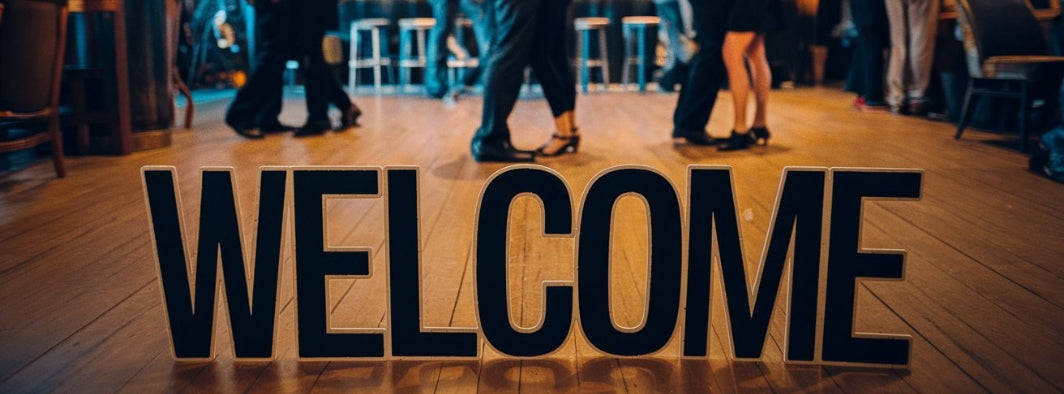Organizing a dance party is more than just an event: it's about providing a space where dancers can gather, practice, and share their passion. Proper organization also helps grow a city's dance community. Here's a comprehensive guide to help you succeed.

1. Find the perfect location
Choosing the right venue is essential to ensuring a pleasant and tailored experience for dancers. Here are the possible options and the key criteria for choosing the right venue:
Main options: dance hall or bar
-
Dance hall: Ideal for a dance-oriented atmosphere, these halls generally offer suitable facilities.
- Advantages: Quality flooring, good acoustics, sound equipment already available.
- Disadvantages: Rental cost can vary between €200 and €500.
-
Bar: A more relaxed option, perfect for attracting a diverse crowd.
- Advantages: No direct rental costs, the atmosphere is friendly.
- Disadvantages: Soils may be unsuitable, and participants must be encouraged to consume to satisfy the owner.

Criteria for selecting the location:
- Floor quality: A smooth, slippery (but not too smooth) floor is essential for smooth, enjoyable dancing.
- Dance space size: Make sure there is enough room. A room that is too small will be uncomfortable, while a space that is too large may lack atmosphere.
- Location: A well-located venue, accessible by public transport or with nearby parking, will more easily attract participants.
- Room atmosphere: The decoration and general atmosphere must correspond to the concept of your evening.
- Practical aspects: Changing rooms, seating area, bar for drinks, air conditioning or ventilation are very appreciated elements.
Tip: Take a tour of the venue in the evening or during the day to assess its atmosphere and amenities.

2. Choose the right DJ
The DJ plays a vital role in the success of your party. Here are some things to consider:
- Musical style: Make sure the DJ is proficient in the expected dance styles (salsa, bachata, kizomba, etc.).
- Ability to read the track: A good DJ knows how to adapt his playlist to the energy of the dancers.
- Personal Network: Some DJs attract their own communities of dancers, which can increase attendance.
- Budget: On average, expect to spend between €100 and €250.
Alternative option: Offer a partnership based on a percentage of the proceeds. This can motivate the DJ to be more involved in the success and promotion of the event.
3. Develop an attractive concept
A well-defined concept allows you to give a strong identity to your evening:
- Theme: Choose a tropical, retro, costume party, or one centered around a specific dance.
- Format: Include an introductory course to attract beginners, and plan for entertainment (shows, rueda, challenges).
- Simplicity and Regularity: Hold your event at a fixed frequency, such as the first Friday of each month. This helps dancers incorporate your event into their routine.
Tip: A simple but welcoming concept, with a friendly atmosphere, builds long-term loyalty among participants.
4. Communicate effectively
Clear and visible communication is crucial to attracting people:
- Social Media: Create a Facebook event and share it on Instagram. Post teasers, playlists, or photos regularly to keep the audience engaged.
- Partnerships: Partner with teachers, dance schools or DJs to reach a wider audience.
- Local coordination: Check the calendar of other events in your city to avoid conflicts and divide the existing community. Good collaboration between organizers benefits everyone.
5. Build a community around your party
For an evening to last, it is essential to bring together a loyal community:
- Create a team: Create a team of friends or volunteers to help you with reception, checkout, or communications. This way, you won't have to manage everything alone.
- Welcome with kindness: Be warm and attentive to participants. A friendly atmosphere makes them want to come back.
- Involve regulars: Ask regular dancers to talk about your evening around them and welcome new ones.
6. Budget and balance point
Here is an estimate of typical costs for an evening:
- Location: Free (bar) to €500 (room).
- DJ: €100 to €250.
- Communication: €50 to €150.
- Decoration and logistics: €50 to €100.
Typical budget example:
- Total expenses: €700.
- Entrance fee: €10.
- Break-even point: 70 participants.
Tip: By starting small, you limit financial risks while testing your concept.
Checklist for organizing your first evening
- Find a suitable venue (dance hall or bar).
- Book a competent and motivated DJ.
- Define a clear concept and a regular frequency.
- Create and promote a social media event.
- Check your local calendar to avoid overlaps with other evenings.
- Form a team to distribute tasks.
- Prepare the logistics: cash register, playlist, decoration, equipment.
- Encourage participants to consume (if evening in a bar).
- Warmly welcome participants and collect their feedback.
- Create a friendly and accessible atmosphere for all.

Conclusion
Throwing a dance party is a demanding but rewarding undertaking. By choosing the right venue, a great DJ, and creating a welcoming atmosphere, you'll lay the foundation for a memorable event. With a simple concept and consistent performance, you'll build a loyal community and contribute to the growth of dance in your city. So, are you ready to get the crowds moving?

